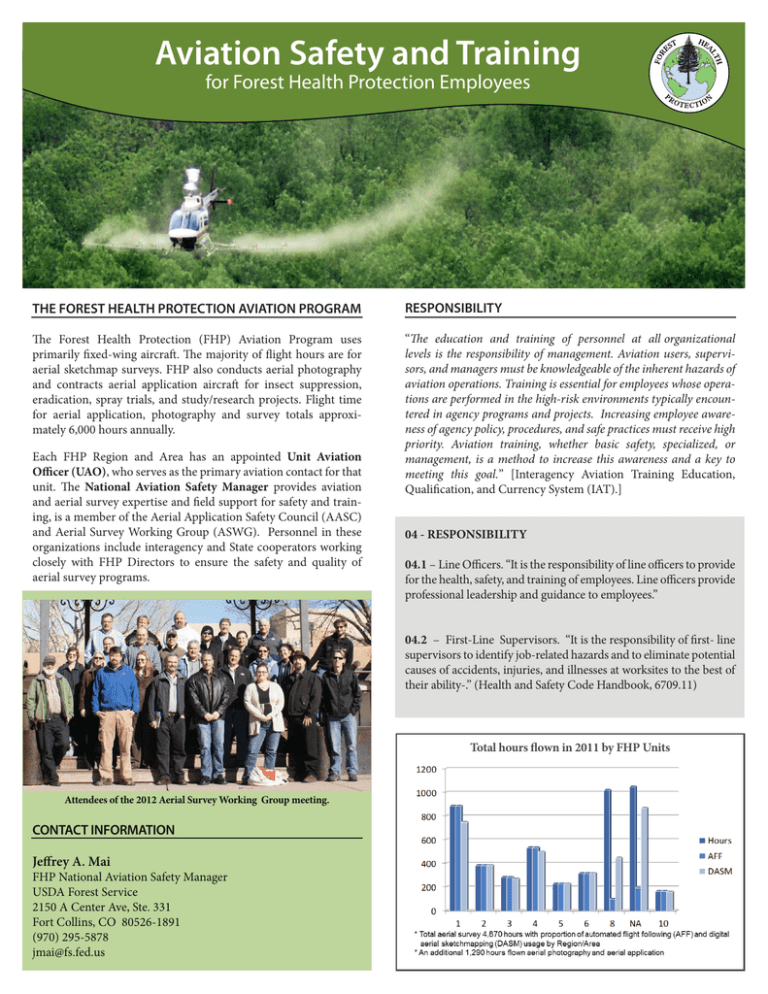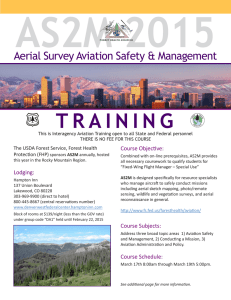Aviation Safety and Training for Forest Health Protection Employees RESPONSIBILITY
advertisement

Aviation Safety and Training for Forest Health Protection Employees THE FOREST HEALTH PROTECTION AVIATION PROGRAM RESPONSIBILITY The Forest Health Protection (FHP) Aviation Program uses primarily fixed-wing aircraft. The majority of flight hours are for aerial sketchmap surveys. FHP also conducts aerial photography and contracts aerial application aircraft for insect suppression, eradication, spray trials, and study/research projects. Flight time for aerial application, photography and survey totals approximately 6,000 hours annually. “The education and training of personnel at all organizational levels is the responsibility of management. Aviation users, supervisors, and managers must be knowledgeable of the inherent hazards of aviation operations. Training is essential for employees whose operations are performed in the high-risk environments typically encountered in agency programs and projects. Increasing employee awareness of agency policy, procedures, and safe practices must receive high priority. Aviation training, whether basic safety, specialized, or management, is a method to increase this awareness and a key to meeting this goal.” [Interagency Aviation Training Education, Qualification, and Currency System (IAT).] Each FHP Region and Area has an appointed Unit Aviation Officer (UAO), who serves as the primary aviation contact for that unit. The National Aviation Safety Manager provides aviation and aerial survey expertise and field support for safety and training, is a member of the Aerial Application Safety Council (AASC) and Aerial Survey Working Group (ASWG). Personnel in these organizations include interagency and State cooperators working closely with FHP Directors to ensure the safety and quality of aerial survey programs. 04 - RESPONSIBILITY 04.1 – Line Officers. “It is the responsibility of line officers to provide for the health, safety, and training of employees. Line officers provide professional leadership and guidance to employees.” 04.2 – First-Line Supervisors. “It is the responsibility of first- line supervisors to identify job-related hazards and to eliminate potential causes of accidents, injuries, and illnesses at worksites to the best of their ability-.” (Health and Safety Code Handbook, 6709.11) Total hours flown in 2011 by FHP Units Attendees of the 2012 Aerial Survey Working Group meeting. CONTACT INFORMATION Jeffrey A. Mai FHP National Aviation Safety Manager USDA Forest Service 2150 A Center Ave, Ste. 331 Fort Collins, CO 80526-1891 (970) 295-5878 jmai@fs.fed.us Aviation Safety and Training for Forest Health Protection Employees TRAINING OPPORTUNITIES FHP AVIATION POSITIONS LISTED IN THE IAT SYSTEM: Forest Health Protection (FHP) is committed to the safety of its aviators and the success of its missions, and to meeting all Interagency Aviation Training (IAT) requirements. Current training opportunities, include: • Agency Administrator (FHP Directors) Basic Aviation Training AOPA – Aircraft Owners and Pilots Association Air Safety Institute provides free on-line Interagency Aviation Training www.aopa.org/asf IAT – Geographic area training events and on-line courses are available to state and federal employees www.iat.gov Forest Health Protection Training • AASM: Aerial Application Safety and Management. Primarily for project personnel and managers responsible for planning and implementing spray programs. Three-day or specially scheduled sessions offered annually. • AS2M: Aerial Survey Aviation Safety and Management. Primarily for sketchmappers and aerial photographers. Four-day sessions are offered annually to help attendees meet IAT requirements for the position, Fixed-wing Manager – Special Use, Aerial Observer. • Task Book: New FHP sketchmappers complete a task book of guidelines that provides them and their trainers with the necessary skills for the position, Fixed-wing Manager – Special Use, Aerial Observer. • Workshops: Many FHP members and their State cooperators hold annual pre-season workshops on safety, survey methodology, and local information. • On the Job Training and Mentoring in flight: Aerial sketchmapping is a skill that takes many hours of practical work outside the classroom. At these sessions, trainees conduct aerial surveys under the guidance of a journey level observer. • Aviation Management/Technical Specialist (Program Manager) • Contracting Officer’s Representative (COR) (Contract Administrators) • Fixed-wing Manager – Special Use (Aerial Surveyor) • Aircrew Member (Trainee or second observer) • Project Aviation Manager (Aerial spraying or remote sensing) • National Aviation Safety Manager • Supervisor (First or second line managers who usually do not fly) • Unit Aviation Officer (Regional or Area FHP UAO) For training requirements for thes e positions, go to http://www.fs.fed.us/foresthealth/aviation/ FOREST HEALTH PROTECTION AVIATION OFFICERS: Jeff Mai National Aviation Safety Manager Dan Zimmerman Northeastern Area Aviation Officer Marc Roberts St Paul Field Office Dan Twardus Morgantown Field Office Bill Frament Durham Field Office Kathy Matthews Regions One and Four Brian Howell Region Two Crystal Tischler Region Three Zack Heath Region Five Keith Sprengel Region Six Rusty Rhea Region Eight Tom Heutte Region Ten



